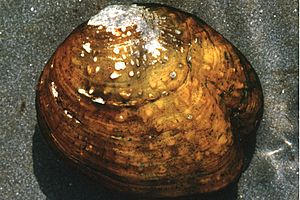Cumberland monkeyface pearly mussel facts for kids
Quick facts for kids Cumberland monkeyface pearly mussel |
|
|---|---|
 |
|
| Conservation status | |
| Scientific classification | |
| Genus: |
Theliderma
|
| Species: |
intermedia
|
| Synonyms | |
|
|
The Cumberland monkeyface pearly mussel (scientific name: Theliderma intermedia) is a special kind of freshwater mussel. It belongs to the family Unionidae, which are also known as river mussels. This aquatic bivalve mollusk is found in rivers in Tennessee and Virginia in the United States. It's called the Cumberland monkeyface because its shell can sometimes look like a monkey's face!
Contents
About the Cumberland Monkeyface Mussel
The Cumberland monkeyface mussel has a greenish-yellow shell. These mussels can live for a very long time, sometimes up to 35 years or even more! They are a medium-sized mussel and can even produce small pearls inside their shells.
How Mussels Grow
Like other mussels, the Cumberland monkeyface starts its life in a unique way. It has tiny larvae called glochidia. These larvae attach themselves to the gills of certain fish. They stay there and grow until they are ready to become juvenile mussels. Once they are developed, they leave the fish and settle on the riverbed.
The fish that help these mussels grow include the streamline chub (Erimystax dissimilis) and the blotched chub (Erimystax insignis). Mussels grow very slowly. It can take months or even years for them to become adults. They also reproduce slowly, which makes it harder for their populations to recover.
Where They Live
Historically, the Cumberland monkeyface mussel was found in many parts of the upper Tennessee River system. Today, their numbers have greatly decreased. They now only live in two specific rivers: the Duck River and the Powell River. Sadly, they have completely disappeared from the Elk River.
Why This Mussel is Important
Cumberland monkeyface mussels play a very important role in their river homes. They are like natural filters for the water. Mussels have special gills that help them breathe and also filter tiny particles of food from the water. This process helps to purify the river water, making it cleaner for other animals and plants.
Why the Cumberland Monkeyface is in Danger
The Cumberland monkeyface mussel is an endangered species. This means it is at a very high risk of disappearing forever. Its populations have shrunk a lot because of several problems:
- Habitat Loss: Their homes in the rivers are being destroyed. This can happen when rivers are changed for human use, like building dams.
- Water Pollution: Pollution from human activities makes the water unhealthy for mussels. They need clean water to survive.
- Slow Growth and Reproduction: Because these mussels grow and reproduce very slowly, it's hard for their numbers to bounce back once they start to decline.
Protecting these mussels helps keep our rivers healthy.


